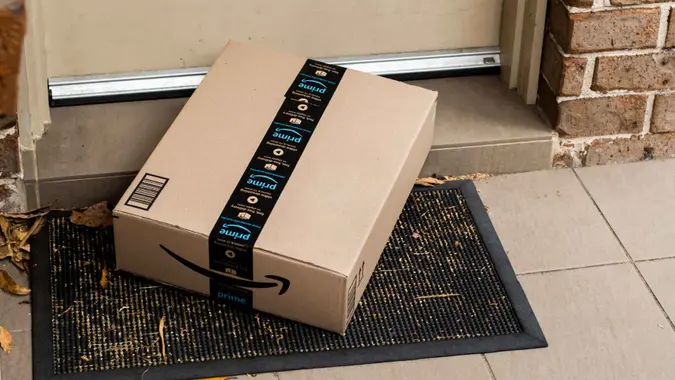A New Amazon Scam Is Targeting Members Ahead of Prime Day: Here’s How To Avoid It

Commitment to Our Readers
GOBankingRates' editorial team is committed to bringing you unbiased reviews and information. We use data-driven methodologies to evaluate financial products and services - our reviews and ratings are not influenced by advertisers. You can read more about our editorial guidelines and our products and services review methodology.

20 Years
Helping You Live Richer

Reviewed
by Experts

Trusted by
Millions of Readers
It’s an exciting time to be an Amazon Prime member. With Prime Day kicking off on July 8, now is the time you’re probably curating your wish list in preparation for the site’s biggest sale of the year.
Unfortunately, this is also a time when you could fall victim to a new scam targeting Prime members. Here’s what you need to be on the lookout for.
Amazon Prime Membership Scams Are on the Rise
In a notice sent to Amazon Prime members on July 2, Amazon warned of a new scam it’s become aware of.
“We’ve recently noticed an increase in customers reporting fake emails about Amazon Prime membership subscriptions,” the email stated.
According to the note, scammers have been sending fake emails claiming that a member’s Amazon Prime subscription will automatically renew at an “unexpected price.”
“The scammers might include personal information in the emails, obtained from other sources, in an attempt to appear legitimate,” the company stated. “These emails may also include a ‘cancel subscription’ button leading to a fake Amazon login page.”
What To Do If You Receive the Scam Message
If you receive an email that matches the description above, do not click on any links.
“Scammers use fake websites to steal your Amazon login credentials and banking information,” the company stated.
While sometimes the best action is no action, there are steps you can take to ensure that your Prime membership is still secure. Amazon recommended doing the following:
- If you want to verify your Prime membership, open your Amazon mobile app or go directly to Amazon.com. Select “Prime” from the main menu to view your membership status, renewal dates and plan details.
- If you clicked on any suspicious links, monitor your credit and debit card statements for unfamiliar charges and contact your bank immediately about any unauthorized transactions.
- Report suspicious communications to Amazon.com/ReportAScam.
How To Avoid Amazon Scams
There are currently over 200 million Prime members, according to Statista. That means hundreds of millions of people are vulnerable to these scams that can be used to access Amazon accounts and/or payment information.
To protect yourself, Amazon recommended only accessing the site through the mobile app or by typing “Amazon.com” directly into your browser instead of clicking any links.
If you’re unsure if an email you receive from Amazon is authentic, go to your Amazon account and click on the “Message Center.” Any legitimate correspondence you receive from Amazon will appear here as well.
Finally, consider setting up two-step verification for your Amazon account. You can do so by visiting Amazon.com/2SV.
More From GOBankingRates
 Written by
Written by  Edited by
Edited by 
























